Biochemistry Online: An Approach Based on Chemical Logic

CHAPTER 5 - BINDING
D: BINDING AND THE
CONTROL OF GENE
TRANSCRIPTION
BIOCHEMISTRY - DR. JAKUBOWSKI
Last Updated: 03/30/16
|
Learning Goals/Objectives for Chapter 5D: After class and this reading, students will be able to
|
D2. Control of Transcription in Prokaryotes
The regulation of the genes involved in lactose utilization won Jacob and Monod (of MWC fame) the Nobel Prize. Lactose can be used as the sole source of carbon by E. Coli. Three genes are required for lactose utilization, beta-galactosidase (lac Z, cleaves lactose to Gal and Glc), galactoside permease (lac Y, transports Lac into the cell) and thiogalactoside transacetylase (lac A, function unknown). These genes follow one another on the DNA, and have 1 promoter region. On transcription and translation, one long poly-protein is made, which is cleaved post-translationally to form the individual proteins.
Figure: FUNCTION OF PROTEINS IN GALACTOSE UTILIZATION

In addition, another gene, the Gal repressor, is found just upstream of the Gal utilization genes. It has its own promoter (PI). A gene cluster, including promoter and any regulatory DNA sequences is called an operon, for example, the Lac operon. In this case, transcription from the operon is induced in response to a molecular signal - i.e. the presence of lactose, or allolactose. The signal binds to the repressor protein, which is bound to the operator DNA, which in the absence of the signal inhibits transcription. When the signal, in this case allolactose or another beta-galactosides, such as isopropylthiogalactoside (IPTG), binds to the repressor protein, a conformation change occurs in the repressor, resulting in a higher Kd for the operator DNA, and subsequent dissociation of the repressor-galactoside complex. Transcription ensues.
Figure: IPTG and Lactose Structures

IPTG is an inducer of the lac operon but is not a substrate for the enzymes produced.
Figure: INDUCTION OF LAC OPERON

Many analogous but distinct methods are used to control gene transcription in prokaryotes. The control of lac operon transcription is but one example.
Navigation
Return to Chapter 5D: Binding and the Control of Gene Transcription
Return to Biochemistry Online Table of Contents
Archived version of full Chapter 5D: Binding and the Control of Gene Transcription

Biochemistry Online by Henry Jakubowski is licensed under a Creative Commons Attribution-NonCommercial 4.0 International License.